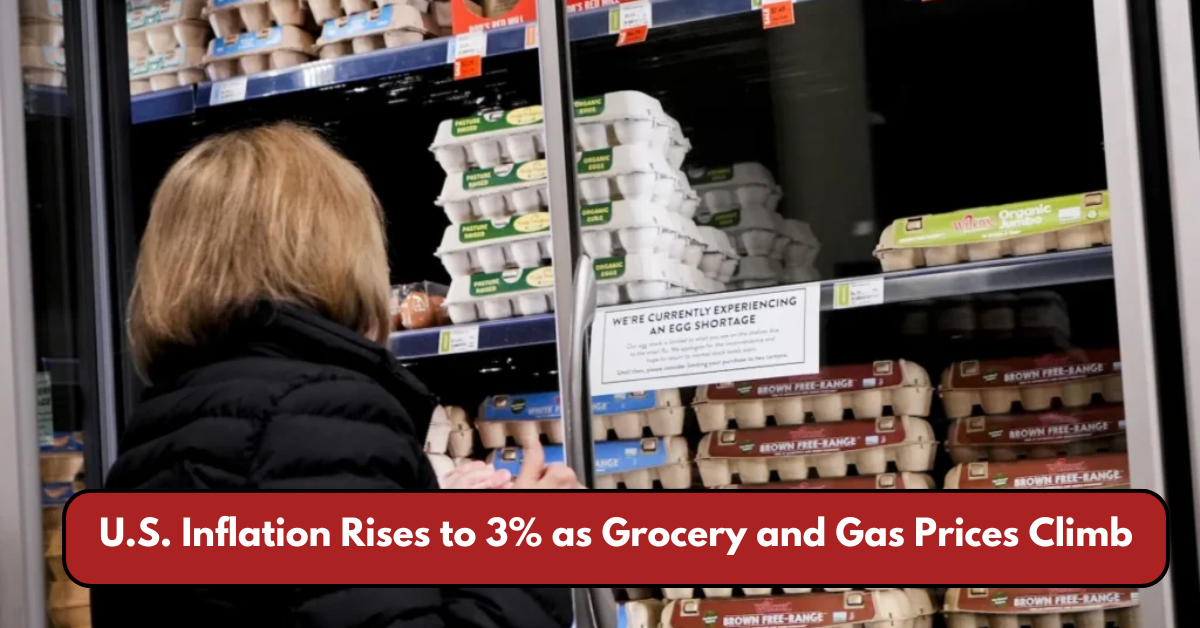The latest economic data released by the U.S. Bureau of Labor Statistics (BLS) shows that inflation in the United States has increased to 3% in January, up from 2.9% in December. This rise in consumer prices is primarily driven by increasing costs in key sectors such as groceries, gasoline, and shelter, impacting millions of Americans.
Key Factors Behind the Inflation Surge
Groceries: A Growing Burden on Households
Grocery prices have surged, with some essential items seeing substantial increases. One of the most significant price jumps has been in eggs, which have increased by 15.2% due to supply disruptions caused by an outbreak of avian flu. Other food items, including dairy and meat, have also risen in price, adding financial strain on American families.
For an official breakdown of food price trends, visit the U.S. Department of Agriculture (USDA) Food Price Outlook.
Gasoline Prices Continue to Rise
Gasoline prices have also contributed to the inflationary pressure, with an uptick that affects transportation and logistics costs. Higher fuel prices not only impact consumers at the pump but also lead to increased shipping costs, which in turn raise prices across various industries.
The U.S. Energy Information Administration (EIA) provides updated fuel price data, accessible here.
Shelter Costs: A Persistent Challenge

Housing costs remain one of the biggest contributors to inflation. Rental prices and homeownership expenses continue to climb, making it more expensive for Americans to secure housing. Rising mortgage rates, influenced by the Federal Reserve’s monetary policy, have further strained affordability in the housing market.
For updated housing market statistics, visit the U.S. Department of Housing and Urban Development (HUD).
Impact on the Federal Reserve’s Policy
The Federal Reserve has been closely monitoring inflation trends as it assesses future monetary policy. While there had been expectations of interest rate cuts in 2024, the latest inflation figures may cause the Fed to maintain its restrictive stance on rates longer than anticipated.
Federal Reserve Chair Jerome Powell recently acknowledged progress in reducing inflation but stressed the importance of keeping interest rates high enough to prevent a resurgence.
For the latest Fed policy updates, visit the Federal Reserve’s official website.
Business and Market Reactions
Financial markets have responded to the inflation data with fluctuations in stock indices. The U.S. dollar index has strengthened in reaction to the report, while some investors have adjusted their expectations regarding future interest rate changes.
Additionally, businesses have raised concerns over rising production costs, particularly in industries affected by tariffs on steel and aluminum. These added costs could lead to further price increases for consumers in the coming months.
What This Means for Consumers?

With inflation remaining above the Federal Reserve’s 2% target, Americans should prepare for continued price volatility in essential goods and services. Households may need to adjust their spending habits to accommodate higher grocery, fuel, and housing costs.
To stay informed about inflation trends, visit the U.S. Bureau of Labor Statistics Inflation Report.
Conclusion
The recent rise in inflation to 3% signals ongoing economic challenges for both consumers and policymakers. While the Federal Reserve aims to bring inflation under control, the increases in food, fuel, and housing costs highlight the persistent struggles faced by many Americans. The coming months will be crucial in determining whether inflationary pressures ease or remain a central concern for the U.S. economy.
For real-time updates and expert analyses, follow government economic reports and trusted financial news sources.
This article has been carefully fact-checked by our editorial team to ensure accuracy and eliminate any misleading information. We are committed to maintaining the highest standards of integrity in our content.

Premlata is a seasoned finance writer with a keen eye for unraveling complex global financial systems. From government benefits to energy rebates and recruitment trends, she empowers readers with actionable insights and clarity. When she’s not crafting impactful articles, you can find her sharing her expertise on LinkedIn or connecting via email at [email protected].




